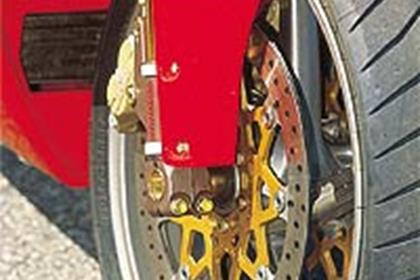The Ducati 998 technical changes
Engine:
The new Testastretta engine is the cornerstone of the 998 range and Ducati’s future sports bike production. It’s an all-new design first shown on the top-of-the-range 996R last year. Testastretta translates as ” narrow head ” in Italian. The engine itself isn’t any thinner than the 996 motor, but the angle between the valves has been reduced from 40° to 25°. That allows a straight inlet duct and flat combustion chamber, along with a more efficient exhaust duct. Together they get the mixture in and the spent gases out faster, making the engine burn more efficiently.
There are also new cams compared to the 996R, which give better bottom and mid-range performance. A bigger bore and shorter stroke creates a flatter combustion chamber, which enables the inlet valves to increase in size from 36mm to 40mm. The exhaust valves have also grown, from 30mm to 33mm. The result is the airflow is significantly increased and the quantity of the fuel/air mixture the engine can cope with is up considerably, too.
The cambelts have been repositioned by moving the tensioners so there’s less stress on them. The result is improved longevity and smoother running. Along with the other changes, that helps the new engine produce a power output of 123bhp compared to the standard 996’s 112bhp at 9750rpm.
To make sure the motor runs cleanly, the 998 has a new, bigger airbox and the same 54mm throttle bodies as the 996R, with a single injector which gives a shower-type spray. The basic 996 had 50mm throttle bodies. There’s an all-new ECU, too, which as well as being about half the size of the box on the 996, can also process information twice as fast. The 998 also gets new 45mm Termignoni aluminium silencers and a more efficient cooling system.
Chassis:
Basically, the 998’s frame is the same as the chassis on last year’s 996R, but with some modifications near the subframe to allow the fitment of the pillion seat and make sure it’s strong enough to take the extra weight.
The Ohlins fully-adjustable rear shock is the same, too, as are the fully adjustable Showa forks, coated with titanium nitride to reduce friction.
The only change to the brakes are thinner, 4.5mm thick front discs, taken from the 996R, which are lighter, reduce the unsprung weight and help the bike turn marginally quicker. The Marchesini wheels are the same as on the 996.
Styling:
IT may not be noticeable, but the fairing has been made slightly fatter to allow the new airbox and frame to fit inside the bodywork. The new cooling system also means the 998 loses the old 996’s side vents. The only other changes to the styling are the graphics.


